Boxster Caliper Upgrade
During one of my Driver Education Weekends, I experienced a brake problem.
What happened was the brake rotors were at the minimum wear thickness (or in
this case, thinness) of 22mm, the brake pads overheated and I ended up with
serious brake fade. I took this as a sign that something had to be done and
fast (i.e. Before my next track day). I could have just replaced the four
rotors with factory pieces and left it at that, but instead I figured that I
may as well give myself better braking while I'm at it.
My first thought was of "Big Reds". I already have the 17"
wheels that are required for this upgrade, but the price of the brakes (and the
extras that go along with it) in Canadian dollars was almost 1/3 of what I paid
for the car, so I figured that was a little much. After talking with friends in
the club about my choices, I decided on swapping in the Boxster monobloc
caliper kit from
Paragon
Products. This kit was reasonably priced, and the new caliper contains four
pistons compared to the old caliper's two. I didn't weigh the calipers, but
from what I remember, the new Boxster caliper is lighter than the heavy cast
iron Carrera caliper which aids in reducing unsprung weight. Of course the pad
is larger so you get some of that weight back
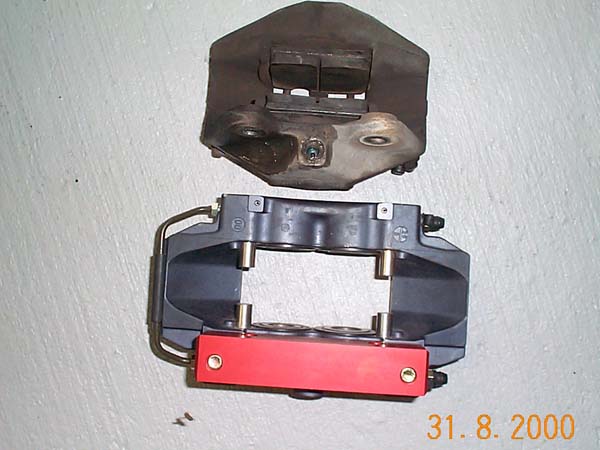 |
| Above is a shot of the original Carrera caliper and the
new Boxster caliper from the bottom. The red block on the Boxster caliper is
the adapter to make the caliper fit. Not only is the new caliper larger and
stiffer (monobloc instead of the two pieces bolted together), it's lighter too.
Hmmmm, 4 pistons. |
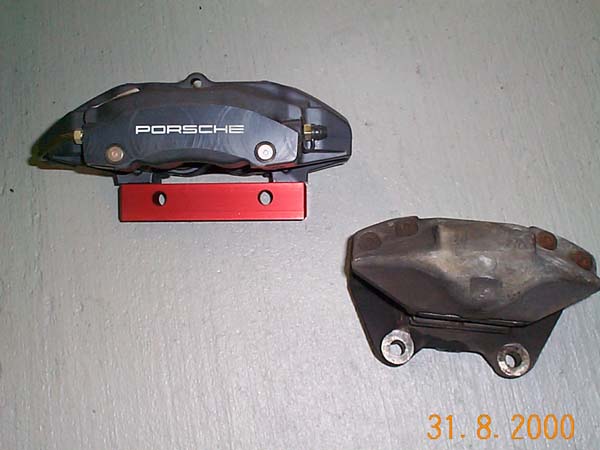 |
Here is another view of the two calipers together. As you
can see, the new caliper is far more pleasing to the eye. |
One consideration of the new brakes was that a stock Carrera rotor could be
used. This of course brings up the question of heat. If the rotor is the same
size, then won't the brakes heat up just as much? I posted some questions about
the mechanics of brakes to the mailing list "Rennlist", and received
a good education that would be useful for anyone upgrading their braking
system.
The first bit of information that we need is what do brakes do exactly and
how do they work. Based on this knowledge, we can determine what advantages and
or disadvantages the Boxster caliper has over the stock Carrera caliper. The
job of the brakes on a car is to slow the car down, and it does this through
the transformation of kinetic energy (the movement of the car) into heat
energy. How it does this seems pretty simple at first. The friction of the
brake pad against the rotor decreases the kinetic energy that is causing the
rotor to rotate and that friction generates heat (and lots of it). But what
exactly is friction?
Friction is the force that which opposes the movement of one surface
over another with which it is in contact, and the coefficient of friction is an
empirical rule that is associated with the force required to move one object
rubbing against another relative to the force with which the two objects are
being pressed together.
Considering this, the amount of pressure applied to the pad pressing it
against the rotor determines how quickly the kinetic energy is turned into heat
energy and thus how quickly the rotor's rotation speed is decreased. So we can
say that the higher the coefficient of friction, the quicker the dissipation of
kinetic energy into heat energy, or push harder on the brakes and you slow down
faster.
With this in mind, we can examine the differences in the two calipers which
can be summed up as: weight of caliper, stiffness of caliper, number of pistons
and size of brake pad. The fact that the Boxster caliper looks better doesn't
help me stop any better. Since I did not weigh the two calipers with their
respective pads, and I don't have any data on the stiffness of either caliper,
I'll leave these two differences aside.
Number Of Pistons: An interesting thing that was posted on Rennlist
was that the overall piston area on the Boxster caliper (2 30mm pistons and 2
28mm pistons per caliper) is actually about 5% smaller than that of the Carrera
caliper ( 2 42mm pistons per caliper). Considering such a small difference in
overall piston area, the master cylinder does not need to be changed and if
anything, your pedal travel should be slightly less due to the smaller amount
of fluid you have to push. This small difference in total piston area also
removes concerns I had about changes in brake bias from the stock system .
Since the overall piston area is close to the same, we examine the
advantages of just the number of pistons (4 vs. 2). The main difference of more
pistons is that the pressure is more evenly distributed across the brake pad.
This has the following advantages:
- reduce hot spots on the pad, which in turn helps reduce brake fade.
- provides better feel which helps in threshold braking
- more even wear.
| This picture shows the difference between the stock Carrera pad
and factory Boxster street pad. As you can see, you get a fair bit more brake
pad to help slow you down. Hmm, that Carrera pad looks a little shinny. You can
see the grove in the bottom of the top pad where the ridge in the worn rotor
was sitting. |
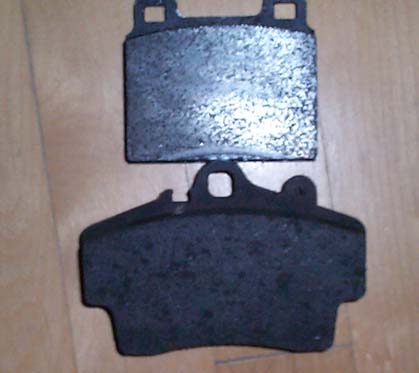 |
Brake Pad Size: Now here is the interesting part. I always though
that the larger the brake pad surface, the more friction you have and
consequently the better the braking force you have.. Well, not quite. If you
look at the definition of the coefficient of friction, you will notice that
surface area is not involved, just pressure. With the larger pad, all that
happens is that the same amount of pressure is distributes over a greater area.
So if no more friction is available, why have a larger pad? Heat. The larger
pad helps dissipate more heat than the smaller pad so the brakes fade less and
consequently you have more braking power.
Another thing about this setup is that the size of the Boxster rotor is
298x24mm, and the size of the stock Carrera rotor is 282.5x24mm. This means
that one could install a slightly larger rotor if they wanted to spend the
extra money on rotors and custom hats and a possible new adapter block to move
the caliper out slightly to allow the new rotor to fit.
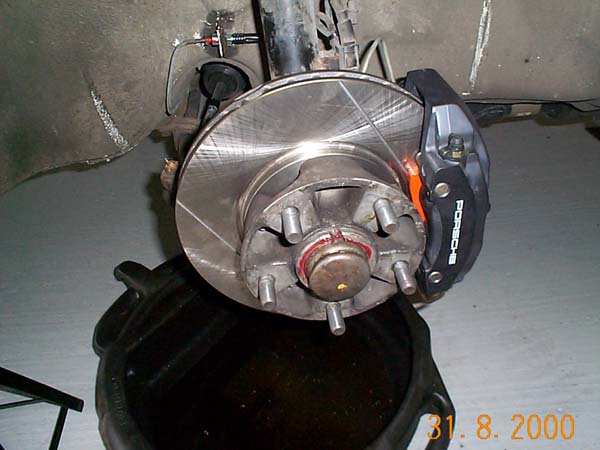 |
This is a shot of the new caliper and rotor
on the car. You can see the edge of the Pagid Orange brake pad peeking out. The
front rotor is the same size as the stock Carrera rotor, but I decided to get a
slotted rotor to help remove the gas that develops between the pad and rotor
surface. Looks cool too!
DOT stainless steel brake lines were also added to help with pedal firmness.
Also evident in this picture is the scrub marks of the front tire on the inner
fender. This was from the 16" Carrera 2 wheels at full lock. I guess the
spacers on the car were no quite enough. |
 |
Here is the front brake duct. I've only had them on for
one track weekend, and I only had one dry run that whole weekend so I didn't
get a good feel for how much extra cooling the rotors will receive, but the one
dry run I had felt god. |
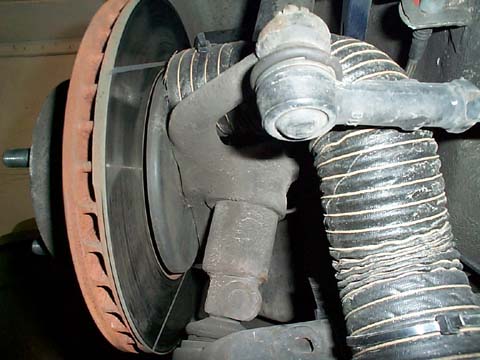 |
A shot of the hose and backing plate to the rotor. |
So was it worth it? Basically the way I see it, you only need brakes big
enough to dissipate the heat you are generating and to be able to lock up your
tires under heavy braking, since you tire will be the limiting element when
traction is concerned. So for me, I find this to be a better setup than the
stock Carrera brakes with the advantages of the 4 piston caliper and the extra
heat dissipation. It will not dissipate as much heat as say 930 brakes or Big
Reds, but it is a lot easier on the budget. I have also added cooling ducts and
the combination seems to work well.
Back to 911 home





